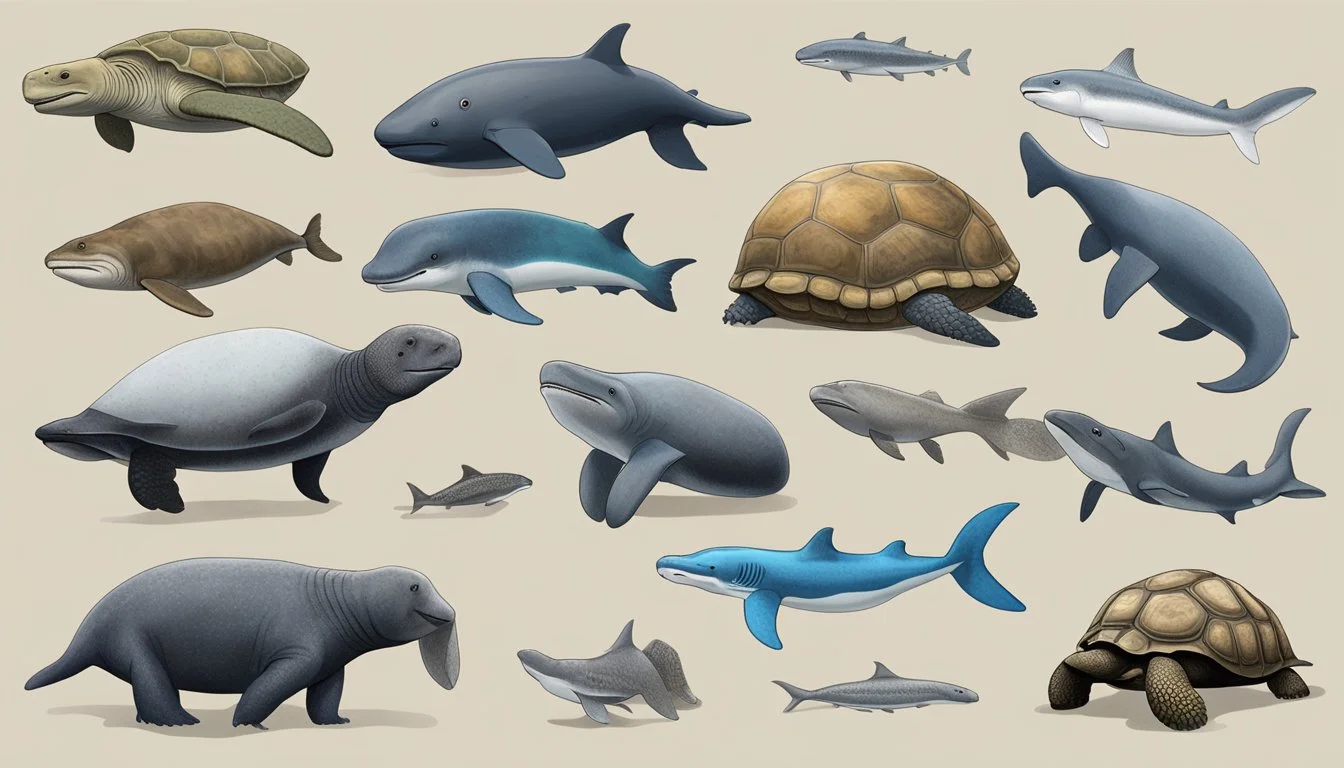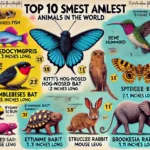Are you curious about the longest living animals on Earth? From tortoises to clams, the animal kingdom is full of creatures that can live for decades, even centuries. In this article, we will explore the top 10 longest living animals and learn about the factors that contribute to their impressive lifespans.
As humans, we are fascinated by the idea of living longer and healthier lives. We look to the animal kingdom for inspiration, hoping to uncover the secrets of longevity. By studying the longest living animals, we can learn about the importance of genetics, environment, and lifestyle in determining lifespan.
Delve into the fascinating world of animal longevity and discover the creatures that have managed to outlive us all.
1) Ocean Quahog
If you’re looking for the longest-living animal in the ocean, look no further than the ocean quahog. This edible clam species is well-known for its long lifespan, with some specimens living for over 500 years.
The ocean quahog is found in the North Atlantic Ocean, and its longevity has been attributed to its slow growth rate and low metabolic rate. These clams can grow up to 4 inches in length and are commonly harvested for food.
Scientists have used the age of ocean quahogs to study changes in the ocean environment over time, making them an important species for research. Despite their long lifespan, ocean quahogs are not immune to environmental threats, and their populations have declined in some areas due to overfishing and habitat destruction.
2) Greenland Shark
The Greenland Shark is one of the longest-living animals on the planet, with a lifespan of up to 400 years. These sharks are found in the cold waters of the Arctic and North Atlantic oceans, and they are known for their slow growth rate. It takes them about 150 years to reach sexual maturity.
Greenland Sharks are also one of the largest living species of shark, growing up to 7 meters in length and weighing up to 1,400 kg. Their diet consists mainly of fish and other sharks, but they have been known to eat seals and even polar bears.
Despite their size and longevity, Greenland Sharks are not considered a threat to humans, as they live in deep waters and are rarely encountered. Their slow movement and low metabolism also make them less aggressive than other shark species.
3) Bowhead Whale
The Bowhead whale, also known as the Arctic whale, is one of the longest living mammals on Earth. They can live for over 200 years, with the oldest known Bowhead whale reaching the age of 211. These whales are found in the chilly Arctic and subarctic waters year-round. They are the fifth largest whale in the ocean, reaching up to 60 feet in length, and are among the heaviest animals on Earth with their weight between 75 to 100 tons. Researchers have found that part of what enables these animals to live for so long is that they rarely succumb to cancer and disease.
4) Galápagos Tortoise
The Galápagos tortoise is one of the most famous and longest-living animals on the planet. These giant tortoises can live for more than 100 years in the wild, and some have even been known to live up to 175 years in captivity. They are found only on the Galápagos Islands, off the coast of Ecuador, and are the largest tortoises in the world.
Galápagos tortoises are herbivores and can weigh up to 900 pounds. They have a slow pace of life and are known for their gentle and peaceful nature. Unfortunately, these amazing animals are endangered due to habitat loss and hunting. Conservation efforts are underway to protect these magnificent creatures and their habitat.
5) Red Sea Urchin
Red Sea Urchins are spiny-skinned creatures that belong to the echinoderm family. They are known to live for over 200 years with no signs of aging. Researchers found that they are far more likely to be eaten by a predator than die of an age-related condition, and a 100-year-old is just as healthy and able to reproduce as a young individual. The Red Sea Urchin is a valuable commodity in the seafood industry, and it is harvested extensively for its roe, which is considered a delicacy in many countries. However, overfishing has led to a decline in their population, and conservation efforts are underway to protect this long-living species.
6) Koi Fish
Koi fish are a type of carp that are known for their vibrant colors and longevity. These fish can live for several decades in the right environment and have been known to live up to 40 years or more in artificial ponds. Koi fish bred in Japan can live longer than those bred outside of Japan, with some living up to 70 years or more.
The oldest koi fish on record, named Hanako, reportedly lived for 226 years. Koi fish are popular among fish enthusiasts and are often kept in outdoor ponds or indoor aquariums. They require a well-maintained environment with appropriate water quality and temperature to thrive. With proper care, koi fish can make excellent long-term pets.
7) Macaw
Macaws are members of the parrot family and are known for their brightly colored feathers.
They are native to the rainforests of Central and South America and can live up to 60-80 years old in the right environment. However, their lifespan varies depending on the species and whether they are in captivity or the wild.
The larger species, such as the Hyacinth Macaw, can live up to 50 years in the wild, while smaller species like the Blue-headed Macaw have a maximum life expectancy of up to 10 years. It’s important to note that the lifespan of a Macaw can also be affected by factors such as diet, exercise, and medical care.
8) Elephant
Elephants are known for their intelligence and long lifespan. They can live up to 70 years in the wild, and even longer in captivity. Elephants are also social animals, often living in groups and forming strong bonds with their family members.
They have a complex communication system, using a variety of sounds and body language to convey different messages. Elephants are herbivores, feeding on a variety of plants and vegetation.
They are also known for their impressive memory, able to remember locations of water sources and food. Elephants are an important part of many cultures and ecosystems, and their conservation is crucial for their survival.
9) Aldabra Giant Tortoise
The Aldabra Giant Tortoise is a massive, long-necked reptile that is native to the Aldabra Islands off the East Coast of Africa. These tortoises are among the biggest types of land tortoise and one of the longest-living animals on the planet.
They have a high carapace in a dome shape which is brown or tan, with four heavily scaled, stocky limbs, a narrow face, and a long neck. Males are considerably larger than females and can weigh up to 550 pounds and have a carapace length of up to 4 feet.
The oldest land animal on Earth is an Aldabra Giant Tortoise named Jonathan, who is reportedly 190 years old.
10) Rougheye Rockfish
The Rougheye Rockfish is a species of fish that is found in the North Pacific Ocean, from California to Japan. It is known for its exceptionally long lifespan, with a maximum recorded age of at least 205 years. These fish typically live at depths between 500 and 1,500 feet, and are characterized by their large, rough eyes, which give them their name.
Rougheye Rockfish are an important part of the marine ecosystem, serving as both predator and prey. They are commonly caught by commercial and recreational fishermen, and are considered a delicacy in some cultures. However, overfishing and habitat destruction have led to declines in their populations in some areas. Conservation efforts are underway to protect these remarkable fish and ensure their survival for future generations.
Unique Adaptations for Longevity
Metabolic Rates
Metabolic rate is a key factor in determining the lifespan of an animal. Generally, animals with slower metabolic rates tend to live longer. This is because slower metabolic rates result in less oxidative damage to cells and DNA over time. Some animals have unique adaptations that allow them to maintain lower metabolic rates throughout their lives.
For example, the naked mole-rat has a lower metabolic rate than other rodents of similar size. This is due to their ability to switch between aerobic and anaerobic metabolism depending on oxygen availability. Additionally, naked mole-rats have high levels of antioxidants that protect against oxidative damage.
Reproductive Strategies
Reproductive strategies can also play a role in an animal’s lifespan. Animals that reproduce later in life or have fewer offspring tend to live longer. This is because reproductive processes can be energetically costly and can lead to increased oxidative damage.
One example of a long-lived animal with a unique reproductive strategy is the bowhead whale. Bowhead whales have a slow reproductive rate, with females giving birth to a single calf every three to four years. This allows them to allocate more energy towards maintenance and repair processes, which may contribute to their exceptional longevity.
It is important to note that while metabolic rates and reproductive strategies can contribute to an animal’s lifespan, there are many other factors at play. Genetics, environmental factors, and lifestyle choices can all influence an animal’s longevity.
Frequently Asked Questions
What is the oldest living species in the ocean?
The oldest living species in the ocean is the Ocean Quahog, a type of clam that can live for more than 500 years. These clams are found in the North Atlantic Ocean and are known for their slow growth rate and long lifespan.
Which land animal boasts the longest lifespan?
The land animal that boasts the longest lifespan is the Galápagos Tortoise. These tortoises can live for more than 100 years in the wild, with some individuals living up to 190 years. They are native to the Galápagos Islands and are known for their slow movements and long lifespans.
How long can the longest-living fish survive?
The longest-living fish is the Greenland Shark, which can live for more than 400 years. These sharks are found in the cold waters of the Arctic and North Atlantic Oceans and are known for their slow growth rate and long lifespan.
What are some animals known to live for centuries?
Some animals known to live for centuries include the Bowhead Whale, which can live for more than 200 years, and the Red Sea Urchin, which can live for up to 200 years. These animals are known for their slow metabolism and ability to survive in harsh environments.
Which animal has the record for the longest life in captivity?
The animal with the record for the longest life in captivity is a Galápagos Tortoise named Harriet, who lived to be 175 years old. Harriet was born in the wild and was brought to Australia in the 1800s, where she lived in captivity until her death in 2006.
What are the lifespans of the top ten longest-living creatures?
The top ten longest-living creatures include the Ocean Quahog, Greenland Shark, Bowhead Whale, Galápagos Tortoise, Red Sea Urchin, Macaw, Geoduck, Rougheye Rockfish, Aldabra Giant Tortoise, and Koi Fish. These animals can live for anywhere from 60 to 500 years, depending on the species.


